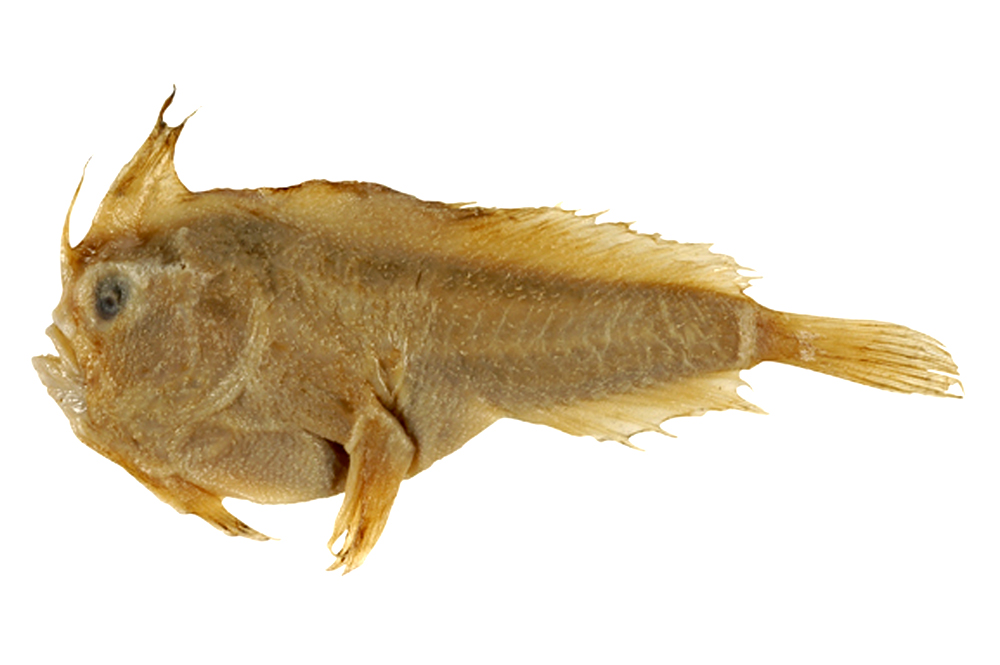Smooth Handfish, Sympterichthys unipennis (Cuvier 1817)

Preserved holotype of the Smooth Handfish, Sympterichthys unipennis - MNHN A 4630, 43.8 mm SL, from Tasmania. Source: Australian National Fish Collection, CSIRO. License: CC BY Attribution-Noncommercial
Summary:
A strongly compressed handfish with rough skin and no warty protuberances or dermal appendages on the head or body. In the original description, the Smooth Handfish was described as being reddish-brown marbled with darker brown. The preserved holotype retains darker markings on the first dorsal fin and membranes of the pectoral, pelvic and caudal fins.
The Smooth Handfish is known only from the holotype, collected by zoologist François Péron in 1802 during Nicolas Baudin's 1800-1803 expedition to Australia.
The Smooth Handfish is known only from the holotype, collected by zoologist François Péron in 1802 during Nicolas Baudin's 1800-1803 expedition to Australia.
Cite this page as:
Bray, D.J. 2023, Sympterichthys unipennis in Fishes of Australia, accessed 27 Jun 2025, https://fishesofaustralia.net.au/Home/species/4324
Smooth Handfish, Sympterichthys unipennis (Cuvier 1817)
More Info
|
Distribution |
Tasmania, precise locality unknown. |
|
Features |
Dorsal fin II + 17; Anal fin 9; Pectoral fin 9; Pelvic fin i, 4; Caudal fin 1+7+1 = 9; Vertebrae 9+13=22. Body moderately elongate, head and body strongly compressed; illicium thick based, thin distally, without dermal spinules; esca a simple filament, minute (possibly damaged); scale bases variable in shape, dendritic to narrowly thallate, with long unicuspid or bifurcate spinules. Second dorsal-fin base in base 64% SL; length of second dorsal-fin spine 1.3 times length of longest ray of second dorsal fin. Skin rough, body densely covered inclose-set, embedded, nonimbricate, spiny scales; scale bases variable in shape, dendritic to narrowly thallate, with long unicuspid or bifurcate spinules (except for those closely associated with pores of the acoustico-lateralis system); spinules adpressed, posteriorly directed, originating from posterior region of scale base, apical spines moderately divergent. No wart-like protuberances and dermal appendages on head or body. |
|
Colour |
In preservative, uniformly yellowish white with darker reddish-brown areas below and above the eyes, and on the pectoral, pelvic and caudal fin membranes; apices of first dorsal fin and anterior rays of second dorsal fin reddish brown; no evidence of vertical dark markings through base and posterior margin of caudal fin; membranes of dorsal and caudal fins translucent; eye bluish black. Its coloration after almost two decades in preservative was described by Cuvier (1817) as reddish brown mottled with darker brown |
|
Etymology |
The specific name unipennis is from the Latin unus (= one) and penna (= feather, plume), possibly in reference to the first dorsal-fin spine that is modified into a lure. Lacépède (1804) described the lure as "a filament terminated by a loose tip" (translation). |
|
Species Citation |
Chironectes unipennis Cuvier 1817, Mémoires du Muséum national d'Histoire naturelle, Paris [1936-1950] 3: 435, pl. 18(3). Type locality: Australian seas, voyage de Péron 1800-1804 [Possibly Tasmania] |
|
Author |
Bray, D.J. 2023 |
|
Resources |
Smooth Handfish, Sympterichthys unipennis (Cuvier 1817)
References
Cuvier, G.L. 1817. Sur le genre Chironectes Cuv. (Antennarius Commerson). Mémoires du Muséum national d'Histoire naturelle, Paris [1936-1950] 3: 418-435 pls 16-18 See ref online
Cuvier, G. 1829. Le Règne Animal, distribué d'après son organisation, pour servir de base à l'histoire naturelle des animaux et d'introduction à l'anatomie comparée. Paris : Déterville Vol. 2, Edn 2, i-xv + pp. 1-406. (as Chironectes unipinnis)
Edgar, G.J., Stuart-Smith, R.D., Cooper, A., Jacques, M. & Valentine, J. 2016. New opportunities for conservation of handfishes (Family Brachionichthyidae) and other inconspicuous and threatened marine species through citizen science. Biological Conservation 208: 174-182. http://dx.doi.org/10.1016/j.biocon.2016.07028
Gill, T.N. 1878. Note on Antennariidae. Proceedings of the United States National Museum 1(31): 221-222 (as Sympterichthys laevis)
IUCN SSC Standards and Petitions Committee. 2021. Sympterichthys unipennis. The IUCN Red List of Threatened Species 2021: e.T123423283A207621852. https://dx.doi.org/10.2305/IUCN.UK.2021-3.RLTS.T123423283A207621852.en. Accessed on 23 August 2023.
Lacépède, B.G.E. 1804. Mémoire sur plusieurs animaux de la Nouvelle-Hollande dont la description n'a pas encore été publiée. Annales du Muséum National d'Histoire Naturelle. Paris 4: 184-211 pls 55-58 (described as Lophius laevis, an invalid name, preoccupied by Lophis laevis Latrielle 1804) See ref at BHL
Last, P.R. & Gledhill, D.C. 2009. A revision of the Australian handfishes (Lophiiformes: Brachionichthyidae), with descriptions of three new genera and nine new species. Zootaxa 2252: 1-77 https://doi.org/10.11646/zootaxa.2252.1.1
Last, P.R., Gledhill, D.C. & Holmes, B.H. 2007. A new handfish, Brachionichthys australis sp. nov. (Lophiiformes: Brachionichthyidae), with a redescription of the critically endangered spotted handfish, B. hirsutus (Lacepède). Zootaxa 1666: 53-68 https://doi.org/10.11646/zootaxa.1666.1.4
Last, P.R. & Gomon, M.F. 2008. Family Brachionichthyidae: Handfishes. pp. 375-376 in Gomon, M.F., Bray, D.J. & Kuiter, R.H. (eds). Fishes of Australia's Southern Coast. Sydney : Reed New Holland 928 pp.
Valenciennes, A. 1837. Des Chironectes (Chironectes, Cuv., Antennarius, Comm.). pp. 389–437 in Cuvier, G.L. & Valenciennes, A. Histoire Naturelle des Poissons. Paris : Levrault Vol. 12 507 pp. pls 344-368.
Whitley, G.P. 1936. Ichthyological genotypes: some supplementary remarks. The Australian Zoologist 8(3): 189-192
Whitley, G.P. 1949. The handfish. Australian Museum Magazine 9(12): 398-403


